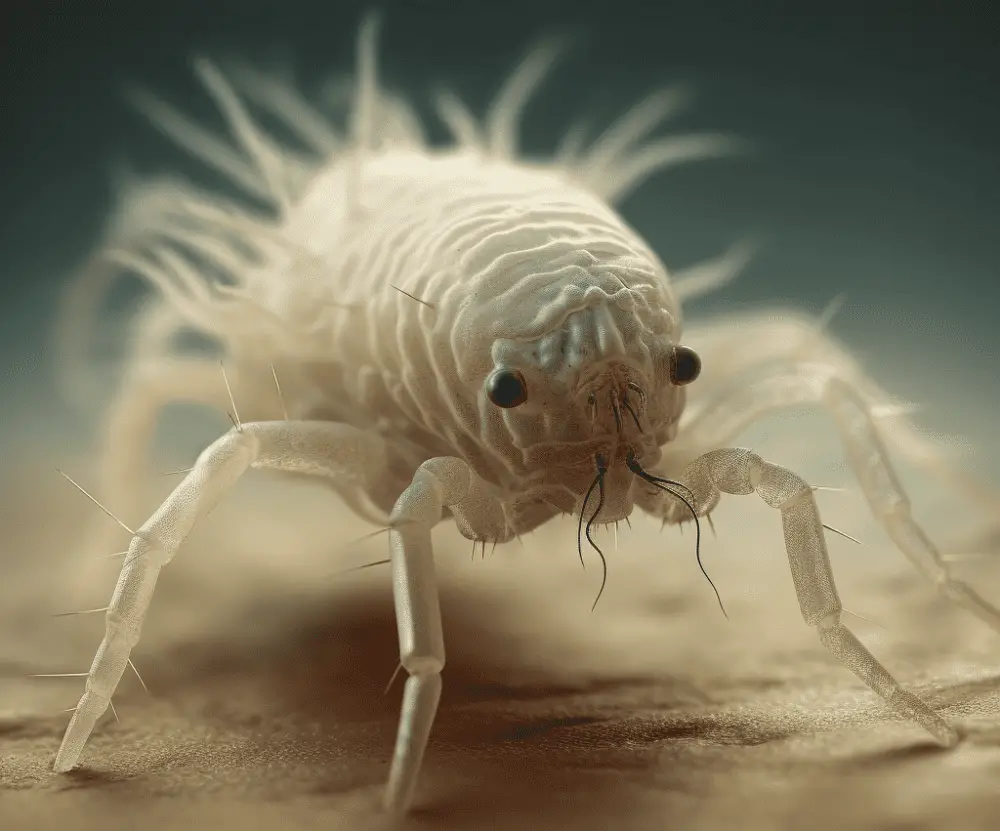Epsom salt, a popular remedy for various ailments, is often used to soothe sore muscles, reduce inflammation, and detoxify the body.
However, its potential to kill Demodex mites – microscopic parasites that reside on human skin – has recently become a topic of interest. These mites can cause several skin issues, such as acne, rosacea, and even contribute to hair loss, making it crucial for individuals to find effective ways to deal with them.
Several remedies have been suggested to address this mite infestation issue, and Epsom salt is one such alternative. It is known for its antimicrobial properties and has been used to treat a range of skin conditions. While it is clear that Epsom salt has numerous benefits, its effectiveness in combating Demodex mites requires further investigation.
Understanding Demodex Mites
Characteristics of Demodex Mites
Demodex mites are microscopic parasites that live in human hair follicles, particularly on the face and eyelashes. They are transparent, with scales and segments, which makes them difficult to see without a microscope.
These mites are part of the normal skin flora and do not generally cause any harm. However, in some cases, an infestation can lead to a skin condition called demodicosis.
Demodex Folliculorum and Demodex Brevis
There are two main species of Demodex mites that affect humans: Demodex folliculorum and Demodex brevis. Demodex folliculorum is more common and primarily found in hair follicles, whereas Demodex brevis is found in sebaceous (oil) glands of the skin.
Both species can contribute to skin issues, but their effects may vary depending on the individual.
Causes of Infestation
A Demodex infestation can occur for various reasons. Age plays a significant role, as adults are more likely to have Demodex mites than younger individuals.
Other factors that may contribute to an infestation include:
- Compromised immune system
- Hormonal imbalances
- Poor hygiene
- Pre-existing skin conditions like rosacea
It’s important to note that not everyone with Demodex mites will experience symptoms or problems. In many cases, these mites coexist harmoniously with their human host.
However, if an infestation does occur, it can lead to skin irritation, redness, and inflammation.
Symptoms and Diagnosis of Demodex Mites Infestation

Identifying Symptoms
Demodex mites are microscopic parasites that live in hair follicles and sebaceous glands on the skin. They are mainly associated with two species: Demodex folliculorum and Demodex brevis. A Demodex mite infestation can cause various skin conditions, including rosacea, eczema, and redness.
Common symptoms of a Demodex mite infestation include:
- Itchiness: The presence of mites can lead to itching, especially on the cheeks and around the eyes.
- Redness and inflammation: Mite infestations may cause redness and inflammation on the skin, particularly on the face.
- Eye irritation: Demodex mites can cause eye irritation, leading to red, itchy, or watery eyes.
While Demodex mites are not contagious, they can spread through personal items such as makeup brushes or towels.
Diagnostic Techniques
If you suspect a Demodex mite infestation, consult a dermatologist for a proper diagnosis. The following diagnostic techniques can help confirm the presence of mites and evaluate the severity of the infestation:
- Skin scraping: A dermatologist may perform a skin scraping to collect samples from the affected area, focusing on the cheeks and areas with visible redness or inflammation.
- Skin biopsy: In some cases, a skin biopsy may be necessary to obtain a larger sample for examination.
- Microscopic examination: The collected samples are then examined under a microscope to identify and count the presence of D. folliculorum or D. brevis mites.
These diagnostic techniques help healthcare professionals accurately determine the presence and extent of a Demodex mite infestation and develop an appropriate treatment plan to alleviate symptoms and improve overall skin health.
Epsom Salt and Its Effects on Demodex Mites
Epsom salt, also known as magnesium sulfate, is a popular home remedy for various ailments and infections. One such issue is the presence of Demodex mites, which are microscopic parasites that live in hair follicles and sebaceous glands.
They are generally harmless but, in some cases, may cause skin irritation or rosacea.
How Epsom Salt May Help
Epsom salt’s primary component, magnesium sulfate, is known for its anti-inflammatory and antimicrobial properties. These qualities may help to reduce the inflammation and redness caused by Demodex mites. Additionally, it is believed that Epsom salt might help in removing excess oils from the skin, which could potentially limit the mites’ food source.
Pedicures are a possible way Epsom salt may be introduced to the skin to combat Demodex mites. During a pedicure, feet are often soaked in a warm solution containing Epsom salt. This soaking process may expose the mites to the salt, potentially reducing their numbers or easing any discomfort related to their presence.
Effectiveness in Killing Mites
While some anecdotal evidence suggests that Epsom salt may help alleviate symptoms associated with Demodex mites, there is limited scientific research available to confirm its effectiveness in actually killing the mites.
It is possible that Epsom salt may create an unfavorable environment for the mites. However, the lack of solid research makes it essential for more studies to be conducted to determine its true efficacy against Demodex mites.
Other Treatments and Remedies for Demodex Mites Infestation
Topical Medications
Several topical medications are effective against Demodex mites infestation. Some commonly prescribed options include ivermectin, crotamiton, metronidazole, permethrin, and benzyl benzoate. These treatments can be applied to affected areas such as the eyelids, nose, forehead, and ear canals.
Follow your doctor’s advice when using these medications to avoid complications.
Tea tree oil has also been found to be an effective home remedy. It can be applied directly to the eyelashes, hair follicles, and other infested skin areas. Be cautious when using tea tree oil on sensitive skin, as it may cause a burning sensation.
Oral Medications
Oral medications like ivermectin and antibiotics may be prescribed for severe cases of Demodex mites infestation that result in conditions such as demodex blepharitis, demodex folliculitis, or dermatitis. These treatments can help control the mite population and prevent secondary bacterial infections caused by the parasites.
Always consult with a healthcare professional about proper dosage and potential side effects.
Home Remedies
- Sulfur products: Sulfur-based soaps and ointments can be effective in reducing Demodex mite populations.
- Salicylic acid: A gentle cleanser containing salicylic acid is suitable for keeping the skin clean without aggravating the infestation.
- Selenium sulfide: Selenium sulfide shampoos might help alleviate infestation by reducing sebum production, which provides a food source for the mites.
Lifestyle Changes
Making certain lifestyle changes can help prevent and manage Demodex mite infestations:
- Maintain good hygiene by regularly washing your face, eyelids, and eyelashes.
- Keep bedding and surroundings clean to minimize the spread of mites.
- Be cautious when using steroid creams and oral medications like chemotherapy or HIV/AIDS drugs, as they may suppress the immune system and increase the risk of infestation.
- Ensure your pets are treated for parasites, as they can also harbor mites.
- Manage conditions like dry eye and meibomian gland dysfunction by speaking with an eye care specialist
Prevention of Demodex Mites Infestation
Skin Care Practices
Exfoliating regularly can help remove dead skin cells and prevent Demodex mite infestations. It’s essential to keep your skin clean by washing your face daily with a gentle cleanser that is suitable for your skin type. Avoid using harsh soaps or abrasive scrubs, which may cause skin irritation.
Environmental Factors
Controlling the environment in which we live can also help reduce the chances of a Demodex infestation. Some preventive measures include:
- Regularly washing bed linens, towels, and clothing in hot water.
- Vacuuming and dusting the home frequently to reduce dust and allergens.
- Using air purifiers to improve the quality of indoor air.
Reducing Risk Factors
Strengthening your immune system is crucial in preventing Demodex mite infestations. A healthy immune system can help combat these mites naturally. To achieve this, consider the following:
- Eating a well-balanced diet rich in fruits, vegetables, and whole grains.
- Engaging in regular exercise to boost overall health.
- Prioritizing stress management techniques like meditation or yoga.
- Getting enough sleep ensures the body has time to repair and rejuvenate itself.
Following these prevention tips should help reduce the risk of a Demodex mite infestation and promote healthier skin.


